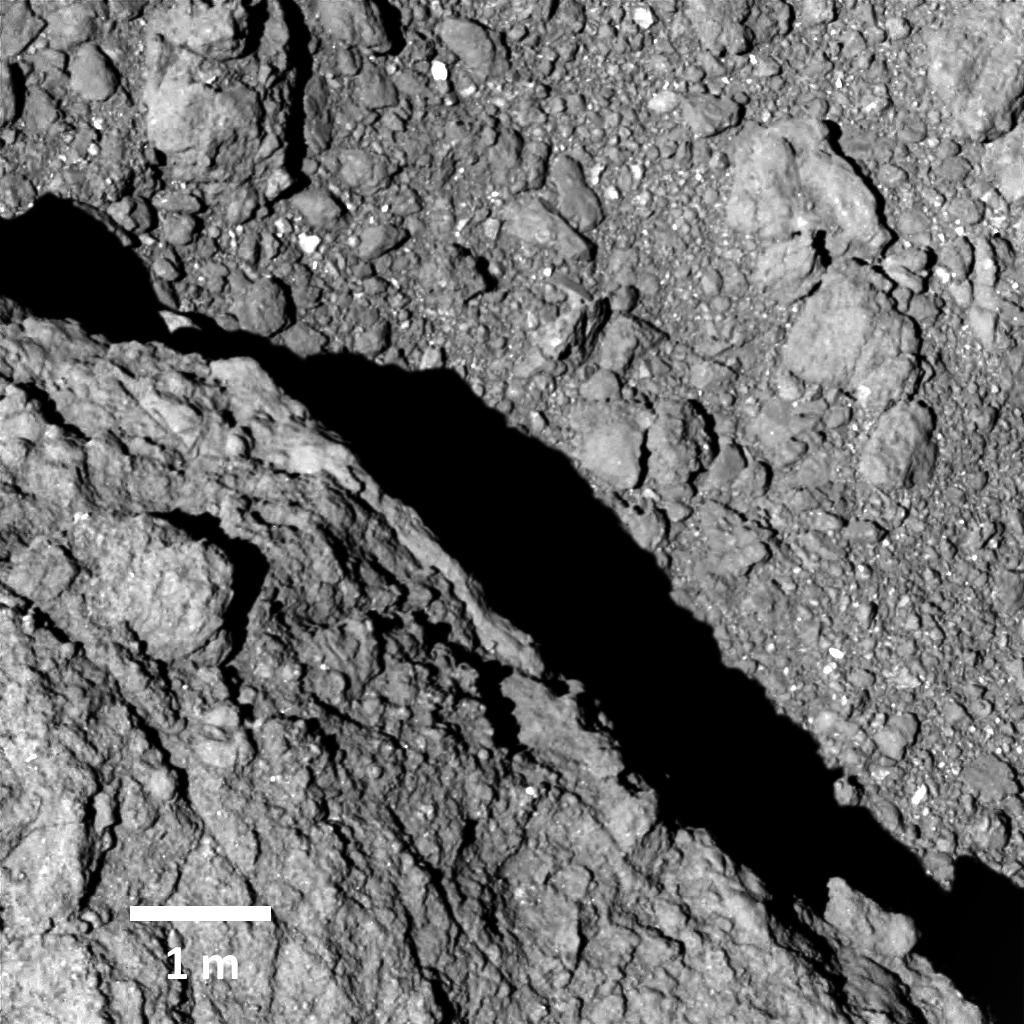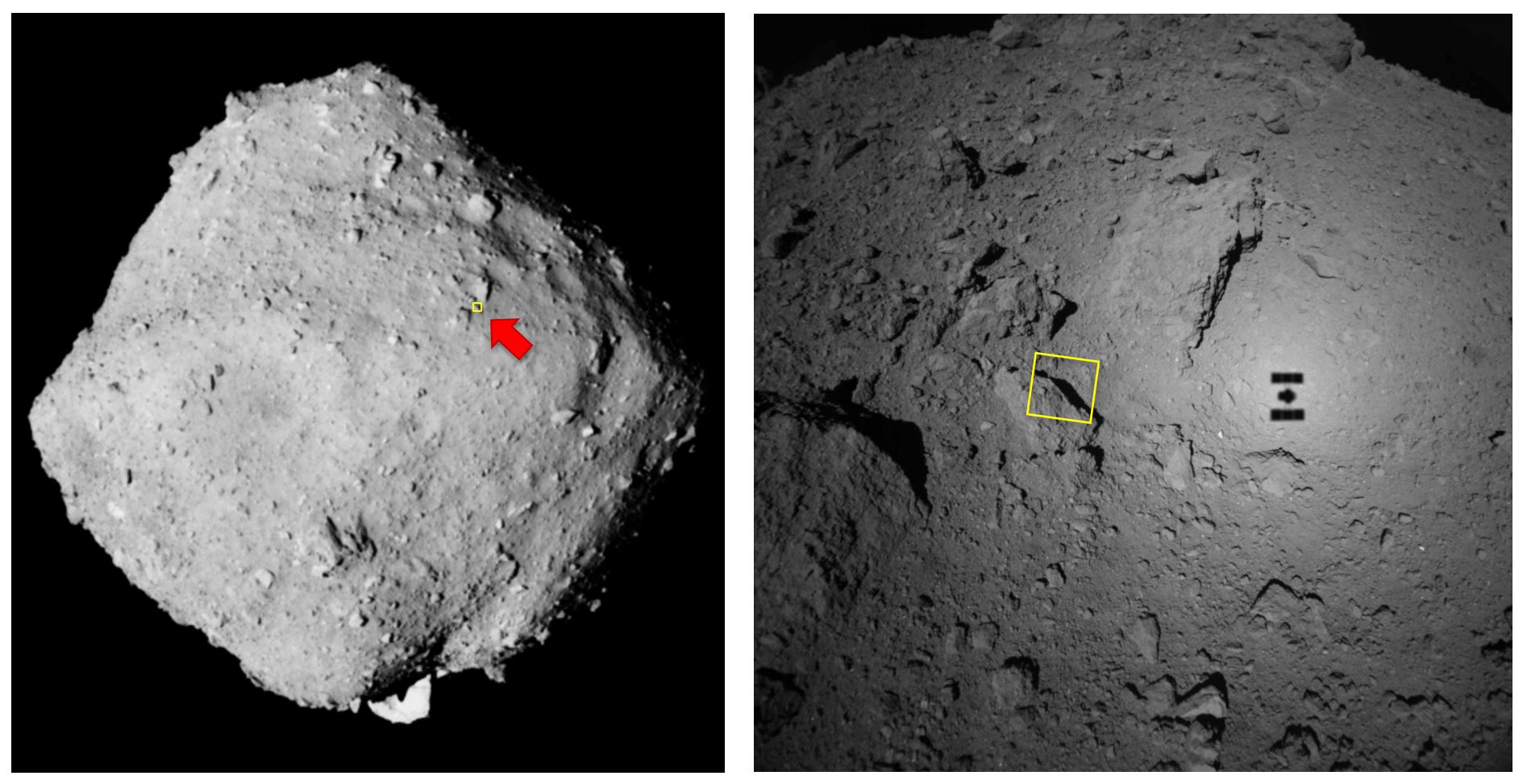
The sharpest-ever photo of the big asteroid Ryugu shows a complex surface strewn with rocks and rubble.
Japan's Hayabusa2 spacecraft captured the image with its Optical Navigation Camera-Telescopic instrument at 12:04 a.m. EDT (0404 GMT) on Sept. 21, 2018, from a height of about 210 feet (64 meters), according to Japan Aerospace Exploration Agency (JAXA) officials.
It's the highest-resolution photo snapped to date of Ryugu's 3,000-foot-wide (900 m) surface, JAXA officials added. [Japan's Hayabusa2 Asteroid Ryugu Sample-Return Mission in Pictures]
Just 2 minutes after the image was taken, Hayabusa2 deployed two tiny, hopping rovers called MINERVA-II1A and MINERVA-II1B toward Ryugu. The little robots stuck their landings in a historic first and are currently exploring the space rock, gathering a variety of data. (Several other spacecraft have touched down softly on an asteroid, but none have been rovers deployed from a mothership like Hayabusa2.)
Another landing will come next week, if all goes according to plan. On Oct. 3, Hayabusa2 is scheduled to deploy a shoebox-size lander named MASCOT, which was built by the German space agency, DLR, in collaboration with the French space agency, CNES.
Like MINERVA-II1A and MINERVA-II1B, MASCOT will move by hopping rather than rolling, which is a good thing, given the roughness of Ryugu's surface, and the asteroid's low gravity, which makes traditional roving a nonstarter. Wheeled vehicles would float away from the rock as soon as they started rolling, Hayabusa2 team members have said.

The $150 million Hayabusa2 mission launched in December 2014 and arrived in orbit around Ryugu in late June of this year. The orbiter also carries another bantam hopper known as MINERVA-II2, an "optional" rover that might be deployed sometime next year. And the mothership will drop down to the surface itself in 2019, snagging samples that will come to Earth in a return capsule in December 2020.
Get the Space.com Newsletter
Breaking space news, the latest updates on rocket launches, skywatching events and more!
The various data gathered at Ryugu, and analyses of the returned sample, should help researchers better understand the early solar system and the role that carbon-rich rocks like Ryugu may have played in helping life get started on Earth, mission officials have said.
NASA has its own asteroid-sampling mission underway, with many of the same goals. The OSIRIS-REx spacecraft is scheduled to arrive in orbit around the near-Earth asteroid Bennu on Dec. 31 and return samples of the rock to Earth in September of 2023.
And about all those acronyms: MINERVA stands for "Micro Nano Experimental Robot Vehicle for Asteroid"; MASCOT for "Mobile Asteroid Surface Scout"; and OSIRIS-REx for "Origins, Spectral Interpretation, Resource Identification, Security-Regolith Explorer."
Follow Mike Wall on Twitter @michaeldwall and Google+. Follow us @Spacedotcom, Facebook or Google+. Originally published on Space.com.
Join our Space Forums to keep talking space on the latest missions, night sky and more! And if you have a news tip, correction or comment, let us know at: community@space.com.

Michael Wall is a Senior Space Writer with Space.com and joined the team in 2010. He primarily covers exoplanets, spaceflight and military space, but has been known to dabble in the space art beat. His book about the search for alien life, "Out There," was published on Nov. 13, 2018. Before becoming a science writer, Michael worked as a herpetologist and wildlife biologist. He has a Ph.D. in evolutionary biology from the University of Sydney, Australia, a bachelor's degree from the University of Arizona, and a graduate certificate in science writing from the University of California, Santa Cruz. To find out what his latest project is, you can follow Michael on Twitter.









